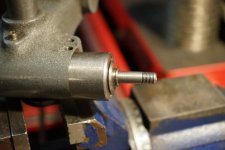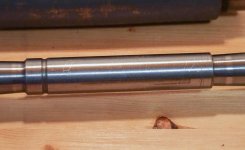Hello,
Long time lurker and avid reader of Practical Machinist here. 99.9% of the time, I've been able to figure stuff out from the collective posted wisdom of the board, but this time I need some help.
I was lucky/unfortunate to get a Dumore 44-011 at a reasonable cost. Better yet, it was pretty complete. However, after carefully dressing a couple of wheels, setting center height, and carefully testing out the grinder, the surface finish indicates perhaps I did not get a stupendous deal. I'm thinking there's a problem in the spindle bearings. They feel a just a tiny bit sticky when rotating by hand, there's just a touch of tightness occasionally. Multiply that by 20,000+ RPM though, and perhaps that's my issue. I have done a bunch of reading, and it sounds like there's a variety of opinions on what the correct replacement bearings are. Ideally a matched set of $200+ class 7 deep groove angular contact bearings seem to be the answer, but people also seem to get by ok on class 3.
My initial question however, is how do I get the darn thing apart? (!) I've successfully loosened both caps with pin vise. getting the cap closest to the belt off is no problem, and it allows you to see the bearing itself, the wave washers, and the knurled gizmo to adjust the pre-load. however, the threaded cap at the grinding wheel end is a different story. I can get it loose, but when I turn the cap seats up against the vaguely flying saucer shaped washer on the quill at the grinding wheel end. Some pictures might better illustrate the description.



I suspect the bearings are original to the grinder, it does not appear that anyone has been monkeying around inside the spindle with aftermarket bearings. I'm hesitant to try and force anything, but do I need to press the spindle out of the bearings somehow? All of the diagrams I can find online of this grinder seem to be of a newer model that has a slightly different part arrangement. I'm hoping to find someone who's replaced bearings in a similar model who can offer a little guidance. Thank you in advance.
Long time lurker and avid reader of Practical Machinist here. 99.9% of the time, I've been able to figure stuff out from the collective posted wisdom of the board, but this time I need some help.
I was lucky/unfortunate to get a Dumore 44-011 at a reasonable cost. Better yet, it was pretty complete. However, after carefully dressing a couple of wheels, setting center height, and carefully testing out the grinder, the surface finish indicates perhaps I did not get a stupendous deal. I'm thinking there's a problem in the spindle bearings. They feel a just a tiny bit sticky when rotating by hand, there's just a touch of tightness occasionally. Multiply that by 20,000+ RPM though, and perhaps that's my issue. I have done a bunch of reading, and it sounds like there's a variety of opinions on what the correct replacement bearings are. Ideally a matched set of $200+ class 7 deep groove angular contact bearings seem to be the answer, but people also seem to get by ok on class 3.
My initial question however, is how do I get the darn thing apart? (!) I've successfully loosened both caps with pin vise. getting the cap closest to the belt off is no problem, and it allows you to see the bearing itself, the wave washers, and the knurled gizmo to adjust the pre-load. however, the threaded cap at the grinding wheel end is a different story. I can get it loose, but when I turn the cap seats up against the vaguely flying saucer shaped washer on the quill at the grinding wheel end. Some pictures might better illustrate the description.



I suspect the bearings are original to the grinder, it does not appear that anyone has been monkeying around inside the spindle with aftermarket bearings. I'm hesitant to try and force anything, but do I need to press the spindle out of the bearings somehow? All of the diagrams I can find online of this grinder seem to be of a newer model that has a slightly different part arrangement. I'm hoping to find someone who's replaced bearings in a similar model who can offer a little guidance. Thank you in advance.





